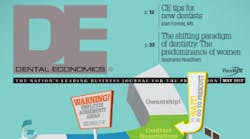Advancing relationships in a fast-paced world
We live in a world that moves faster and faster. This reflects how busy people are today. Between work, family, and all the “screens” available, people are less attuned to forming interpersonal relationships.
For most practices, dentistry is still relationship based. Ideally, patients view their dentists and professional dental team as trusted experts who will maintain their oral health. However, with the pace of the world today, building relationships is more challenging—and more important—than ever before.
Building relationships more quickly
In spite of time constraints, there is a multistep process to building relationships with patients. It’s designed to demonstrate interest in patients as individuals, gather knowledge about them, and simultaneously gain a high level of trust. The following steps will benefit any practice that’s serious about building excellent relationships with patients.
Begin with the Golden 10
Always engage in a friendly conversation before discussing oral health or beginning the examination. The objective is to gather at least 10 personal facts - the Golden 10 - that will enable you and your team to quickly make personal connections with patients during their visits to the practice. These facts can include information about family, type of employment, sports, neighborhood, favorite TV shows, movies, and music, community or charitable activities, and hobbies and other interests.
Personal details make it easier for your practice to develop true rapport with patients. There are other relationship-building benefits as well.
New patients come to practices with various perspectives, ranging from merely wanting a hygiene appointment, to fear and trepidation. Starting off with new patients by learning 10 personal facts relaxes them and helps build trust. It quickly moves the new relationship from one that is merely professional toward one based on friendship. The process of learning about patients as individuals affects how much they ultimately like and trust your dental practice. Any information you gather should be documented in the patient’s file for future reference.
Learn at least one new personal fact during each visit
Once a personal database has been established, any team member can access and supplement information during future interactions. Patients will be flattered that staff members remember their situations and interests and, even though months have gone by, the relationship will be rekindled quickly. Adding more information can be as simple as asking, “What’s new in your life?” Most patients will be delighted to answer and will enjoy the resulting conversation. Each time the practice learns more about patients, it deepens the relationship, enhances how much they value the office, and increases their trust.
Look for opportunities to have contact with patients outside of the office
Examples include calling patients in the evening following treatment to see how they’re doing, or updating them by e-mail about new developments in dentistry or with the practice. Communicating like this establishes additional touch points with patients, making them feel connected to your practice even when they’re not in the office. Patients appreciate outreach from dental practices as long as these contacts somehow relate to dentistry or the practice itself.
Show thoughtfulness about events in patients’ lives
Finally, dentists and staff members can build relationships by reaching out to patients in thoughtful ways, just as they would with their friends. This can be as simple as sending birthday cards to patients or otherwise acknowledging significant events in their lives. For example, there are practices that learn the wedding anniversaries of patients and make a small contribution to a local charity to honor the event. This not only endears the practice to the patients but demonstrates its commitment to supporting the community, in itself another way of strengthening the patient-practice relationship.
Conclusion
These suggestions go directly to the heart of relationship building. Patients appreciate it when practices take an interest in them as individuals, and they’ll be more inclined to remain loyal to a doctor and team they know and respect. These relationship-building strategies will enable your practice to develop strong interpersonal relationships with patients even though this complex and fast-paced world allows little time for making such connections.
Author’s note:
Need CE this year? Attend one of Dr. Levin’s upcoming “Building the Ultimate Practice” seminars. Visit levingroup.com/gpseminars for more information.
Roger P. Levin, DDS, is the chairman and CEO of Levin Group Inc., a leading dental consulting firm. A nationally recognized speaker, Dr. Levin presents practice management seminars throughout the country.
About the Author
Roger P. Levin, DDS, CEO and Founder of Levin Group
Roger has worked with more than 30,000 practices to increase production. A recognized expert on dental practice management and marketing, he has written 67 books and more than 4,000 articles, and regularly presents seminars in the US and around the world. To contact Dr. Levin or to join the 40,000 dental professionals who receive his Practice Production Tip of the Day, visit levingroup.com or email [email protected].

